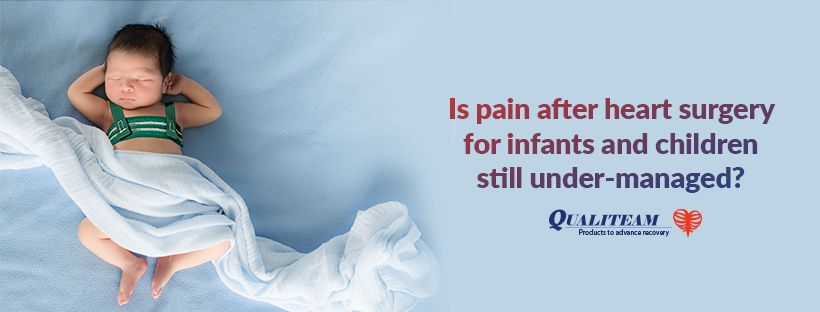Chest supports are a non-pharmacologic approach and an adjunctive treatment of pain.
"Data from children hospitals around the world reveal that pain in pediatric patients infancy to adolescence is common under-recognized and under-treated." This was the staggering introduction in a 2020 publication [1] in Pain Reports.

The authors continue: “Compared with adult patients, pediatric patients with the same diagnoses receive less analgesic doses, and the younger the children are, the less likely it is that they receive adequate analgesia in the medical setting”.
While children from 0 to 17 years are a vulnerable population, infants and neonates are particularly exposed. Often no analgesic strategies are used in infants for procedures like venipuncture, heel lance, and insertion of a peripheral venous catheter, and neonates admitted to intensive care units frequently suffer through an average of 7 to 17 of these painful procedures per day [2]. Even if it is well known that such interventions produce pain, inflammation, and stress, only 2-21% of the infants received analgesia or anesthesia in the Neonatal Intensive Care Unit procedures [3].
If you are surprised and want to know how this is possible, we have to dig into history. During the most part of the 20th century research and clinical practice doubted that infants and young children could feel pain, or detect and process harmful stimuli.

This infant pain denial was caused by experimental research in the 19th and early 20th centuries using pinprick and electric shock. Usually the results were explained as evidence of infants' underdeveloped pain perception due to lack of brain maturation. Harmful stimuli that caused clear reactions were often disregarded as reflex responding. The experimental research lead anesthesiologists to use less anesthesia for infants, and surgery was routinely done with minimal or no anesthesia up till the 1980’s [4].
Fear of addiction and negative long-term outcome related with the use of opiates also play a role in explaining the under-management of pain for infants and children that is still ongoing today.
Some change in attitude started in the ’80’s after ground breaking studies documented pain in infants by measuring hormonal-metabolic responses to surgical procedures performed under minimal anesthesia. It has also been shown that pain early in life significantly increases the risk for developing disorders of anxiety, depression and potentially PTSD later in life. It is therefore crucial to use specific and appropriate analgesic/anesthetic regimes for infants [3]. Unfortunately, there is still some misperception that infants and children do not feel pain today 30 years after the 80’s studies [4, 5].
With increasing recognition that infants and children indeed feel pain, researching strategies for pain management, both pharmacologic and non-pharmacologic, have also increased. However, non-pharmacologic approaches to pain relief are under-appreciated, under-utilized, and under-studied [6].
As the only manufacturer of postoperative chest supports for infants, toddlers, and children, it is not uncommon to hear comments like “kids don’t need chest supports, they don’t have much pain and heal quickly” when presenting these as a non-pharmacologic tool to help manage pain.
As we have seen reported in literature pain in pediatric patients from infancy to adolescence is “common, under-recognized and under-treated”[1]. Opening of the breast bone for access to the heart for repair causes tremendous stress on the thorax, the ribs and the respiratory muscles and all will be sore and cause pain - also in infants, toddlers and children.

Chest supports are a non-pharmacologic approach and an adjunctive treatment of pain after heart surgery. The elastic, comfortable surrounding binder, supports the sore chest and gives the kids a feeling of security. In recognition of the need for comfort, the binder is supplied with a plushy toy dog wearing a binder with the purpose to help the kids to understand how the binder can help them manage pain. The older kids also get a coloring book featuring the plushy dog illustrating the Instructions for Use, - which is a good distraction too.
We have discussed pain in children after heart surgery in a previous Blog (A guide to pediatric pain following open heart surgery) in which we referred to a study showing the positive effect toys can have on children’s - and their parent’s anxiety [7]. Increased awareness and recognition of postoperative pain in infants, toddlers and pediatric patients should result in improved pain management that includes non-pharmacological methods such as external chest supports and educational toys.
- Friedrichsdorf SJ, Goubert L. Pediatric pain treatment and prevention for hospitalized children. PAIN Reports http://dx.doi.org/10.1097/PR9.0000000000000804
- Anand KJ, Barton BA, McIntosh N, Lagercrantz H, Pelausa E, Young TE, Vasa R. Analgesia and sedation in preterm neonates who require ventilatory support: results from the NOPAIN trial. Neonatal outcome and prolonged analgesia in neonates. Arch Pediatr Adolesc Med 1999; 153:331–8.
- Victoria NC, Murphy AZ. Exposure to early life pain: long term consequences and contributing mechanisms. Curr Opin Behav Sci 2016;7:61–8.
- Rodkey EN, Pillai Riddell R. The infancy of infant pain research: the experimental origins of infant pain denial. J Pain. 2013; 14:338–350. [PubMed: 23548489]
- Unruh AM, McGrath PJ. History of pain in children. Oxford Medicine Online. DOI:10.1093/med/9780199642656.003.0001
- Hall RW, Anand KJS. Pain Management in Newborns. Clin Perinatol. 2014 Dec; 41(4): 895–924. doi:10.1016/j.clp.2014.08.010
- Ghabeli F, Moheb N, Nasab S. Effect of Toys and Preoperative Visit on Reducing Children's Anxiety and their Parents before Surgery and Satisfaction with the Treatment Process. J Caring Sci. 2014 Mar; 3(1): 21–28. https://www.ncbi


Leave a comment: